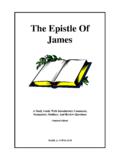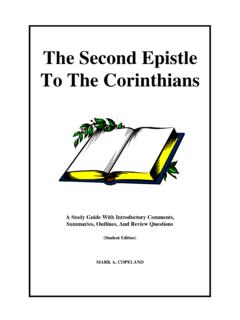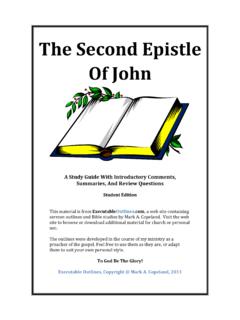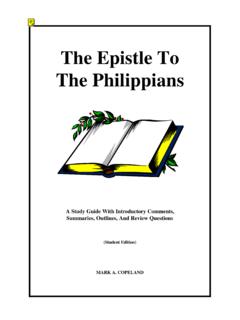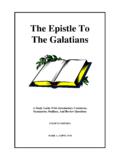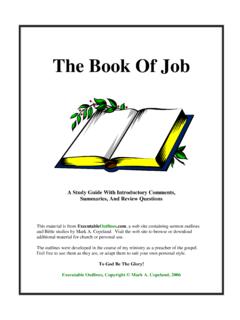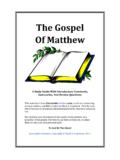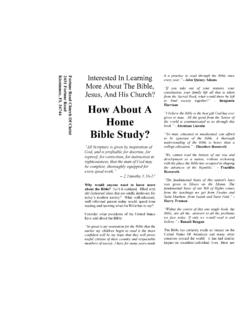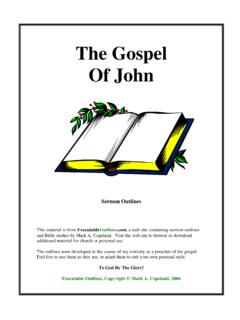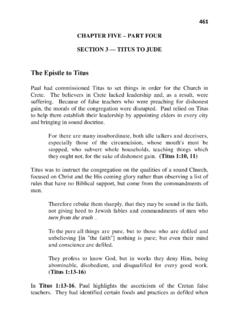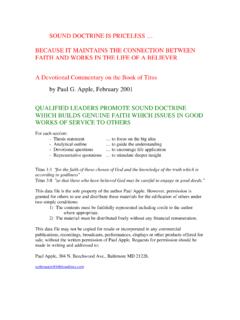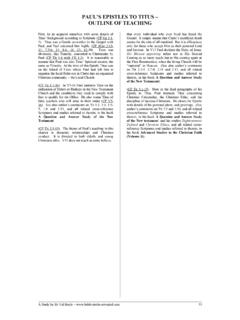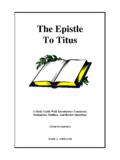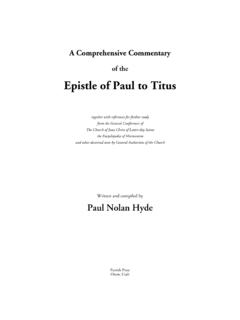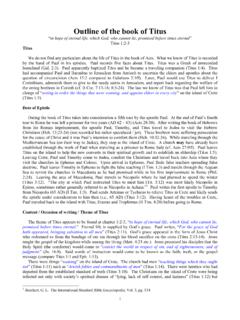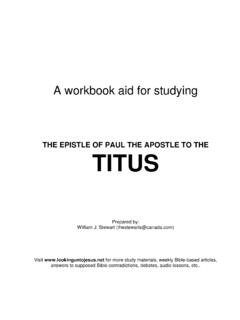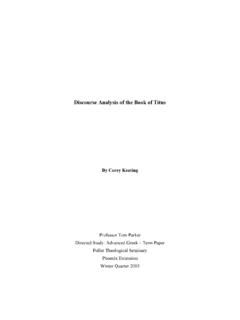Transcription of The Epistle To Titus - Executable Outlines
1 The Epistle To Titus A Study Guide With Introductory Comments, Summaries, Outlines , And Review Questions MARK A. COPELAND. Mark A. Copeland The Epistle To Titus Table Of Contents Introduction 3. Chapter One 7. Chapter Two 11. Chapter Three 14. This study guide was developed in preparation for teaching adult Bible classes. w The objectives for each section are usually things I plan to emphasize during the class. w I have found that summarizing and outlining helps me to better understand the Word of God. It is a practice I highly recommend to others. w I generally delete the answers to the review questions before printing the material and giving it to the students. But that you might know what answers were intended by the questions, I have included them in these guides.
2 This material is from , a web site containing sermon Outlines and Bible studies by Mark A. Copeland. Visit the web site to browse or download additional material for church or personal use. The Outlines were developed in the course of my ministry as a preacher of the gospel. Feel free to use them as they are, or adapt them to suit your own personal style. To God be the glory! Executable Outlines , Copyright Mark A. Copeland, 2001. The Epistle To Titus 2. Mark A. Copeland The Epistle To Titus Introduction AUTHOR. The apostle Paul, as stated in the salutation (1:1). The testimony of church history also provides overwhelming support that Paul is the author. RECIPIENT. Titus , Paul's "true son in common faith" (1:4). There is no mention of Titus by name in the book of Acts, but we can glean much about him from the epistles of Paul.
3 He was a Gentile by birth (Ga 2:3), and accompanied Paul to Jerusalem during the controversy over circumcision (Ac 15:1-2; Ga 2:1-5). During Paul's third missionary journey, Titus became his personal emissary to the church at Corinth, seeking to learn how they received his first letter. When Titus did not return to Troas as expected, Paul anxiously went on to Macedonia (2 Co 2:12-13). It was there that Paul and Titus finally connected, much to the relief and comfort of Paul when Titus reported how well he was received by the Corinthians (2 Co 7:5-7,13-15). Paul then sent Titus and two others back to Corinth, bearing the letter we call Second Corinthians, and exhorting the brethren to complete their collection for the needy saints in Jerusalem (2 Co 8:16-9:5).
4 At the time of the Epistle to Titus , he had been left on the island of Crete by Paul to "set in order the things that are lacking, and appoint elders in every city" (Ti 1:5). If Paul's plans as expressed in this Epistle materialized, then Titus left soon after the arrival of Artemas or Tychicus, and met Paul at Nicopolis in northwest Greece (cf. Ti 3:12). We last read of Titus that he had gone to Dalmatia (in modern day Yugoslavia) during the final days of Paul's life (2 Ti 4:10). TIME AND PLACE OF WRITING. The general consensus is that following his first imprisonment in Rome the apostle Paul was released and allowed to travel for several years before being arrested again. The following itinerary has been proposed by the Ryrie Study Bible: w Paul was released from his house arrest in Rome (where we find him at the end of Acts), probably because his accusers did not choose to press their charges against him before Caesar (Ac 24:1; 28:30).
5 Their case, therefore, was lost by default, and Paul was freed. w Paul visited Ephesus, left Timothy there to supervise the churches, and went on to Macedonia (northern Greece). w From there he wrote 1 Timothy (1 Ti 1:3). The Epistle To Titus 3. Mark A. Copeland w He visited Crete, left Titus there to supervise those churches, and went to Nicopolis in Achaia (southern Greece, Ti 3:12). w Either from Macedonia or Nicopolis, he wrote this letter to encourage Titus . w He visited Troas (2 Ti 4:13), where he was suddenly arrested, taken to Rome, imprisoned, and finally beheaded. w From Rome, during this second imprisonment, he wrote 2 Timothy. It cannot be established with certainty, but it possible that Paul wrote this letter from Corinth, sometime around 63-66 PURPOSE OF THE Epistle .
6 Like his first Epistle to Timothy, this letter is written to a young preacher assigned a difficult task. Evidently the churches on the island of Crete were in need of maturation, and this letter is designed to assist Titus in that work. Therefore, Paul wrote to encourage Titus : w To see that qualified elders were appointed in every city (1:5-9). w To preach things befitting "sound doctrine" (2:1). w To exhort the brethren to be "zealous for good works" (2:14; 3:1,8,14). THEME OF THE Epistle . The key phrase in this Epistle is "good works" (1:16; 2:7,14; 3:1,8,14). An appropriate theme for this Epistle might therefore be: "MAINTAIN GOOD WORKS!". KEY VERSE: Titus 3:8. "This is a faithful saying, and these things I want you to affirm constantly, that those who have believed in God should be careful to maintain good works.
7 These things are good and profitable for men.". outline . INTRODUCTION (1:1-4). I. INSTRUCTIONS CONCERNING CHURCH ORGANIZATION (1:5-16). A. QUALIFICATIONS OF ELDERS (1:5-9). The Epistle To Titus 4. Mark A. Copeland B. CHARACTERISTICS OF FALSE TEACHERS (1:10-16). II. INSTRUCTIONS CONCERNING CHRISTIAN CONDUCT (2:1-3:11). A. FOR THE OLDER MEN AND WOMEN (2:1-3). B. FOR THE YOUNGER WOMEN AND MEN (2:4-8). C. FOR THE SERVANTS (2:9-14). D. FOR THE BRETHREN IN GENERAL (3:1-11). CONCLUSION (3:12-15). REVIEW QUESTIONS FOR THE INTRODUCTION. 1) What were the circumstances in which we first find Titus and Paul together? (Ga 2:1-5). - Titus had accompanied Paul in attending the conference in Jerusalem regarding circumcision 2) Why was Paul adamant in not allowing others to compel Titus to be circumcised?
8 (Ga 2:3-5). - Titus was a Greek, not a Jew; to force him to be circumcised would violate the truth of the gospel 3) With what church did Titus serve as Paul's messenger? (2 Co 7:6-7,13-14). - The church at Corinth 4) Why did Paul send Titus along with the second letter to Corinth? (2 Co 8:16-9:5). - To make sure that the Corinthians' gift for the needy saints in Jerusalem would be ready 5) From where and when was this Epistle to Titus possibly written? - From Corinth, sometime between 63-66 6) Where was Titus when this letter was written to him? (1:5). - On the island of Crete 7) In this Epistle , what three things does Paul exhort Titus to do? (1:5-9; 2:1; 3:1,8,14). - To see that qualified elders were appointed in every city - To preach things befitting "sound doctrine".
9 - To exhort the brethren to be "zealous for good works". 8) What is the theme of this Epistle , as suggested in the introductory material? - Maintain Good Works! The Epistle To Titus 5. Mark A. Copeland 9) What is proposed as the key verse? - Titus 3:8. 10) According to the outline above, what are the main points of this Epistle ? - Instructions concerning church organization - Instructions concerning Christian conduct The Epistle To Titus 6. Mark A. Copeland The Epistle To Titus Chapter One OBJECTIVES IN STUDYING THIS CHAPTER. 1) To review the qualifications for elders in the church 2) To examine the work of elders related to the Word of God SUMMARY. Paul begins by identifying himself as a servant and an apostle whose service is according to the faith of God's chosen people and the truth which is according to godliness.
10 It is also in hope of the eternal life promised by God before time began, and whose word is now being manifested through preaching. He then greets Titus as his "true son in the common faith", bestowing upon him grace, mercy and peace from God the Father and Jesus our Savior (1-4). Paul quickly addresses the reason he left Titus in Crete, to set in order what things were lacking and to appoint elders in every city. To assist him in that task, Paul reviews the qualifications necessary for those who would be appointed as elders (5-9). The last qualification for elders (being able to convict those who contradict) leads right into the final section of this chapter, in which Titus is told to sharply rebuke those of the circumcision who through insubordination and deceit had been subverting entire households, acting just like the characterization made by one of the ancient Cretan prophets.
